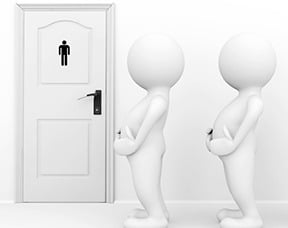Treatment for urinary incontinence (UI) depends on the type of incontinence, its severity and the underlying cause. Behavioral treatments are a group of interventions that improve urinary incontinence and lower urinary tract symptoms by changing the patient’s daily habits or environment or teaching new skills. With the exception of functional incontinence, most cases of incontinence will almost always improve with the behavioral techniques below.
Pelvic Floor Muscle Training
Pelvic floor (Kegel) exercises help to strengthen some of the muscles that control the flow of urine. Strong pelvic floor muscles can hold in urine more effectively than weak muscles. These exercises are used to treat urge or stress incontinence. To perform Kegel exercises:
- Squeeze the same muscles you would use to stop your urine. Your belly and thighs should not move.
- Hold the squeeze for 3 seconds, then relax for 3 seconds.
- Start with 3 seconds, then add 1 second each week until you are able to squeeze for 10 seconds.
- Repeat the exercise 10 to 15 times a session. Do three or more sessions a day.
Kegel exercises can be done when you are at home or away from home and without the need of special equipment at any time during the day. Your doctor can help to instruct you on the proper technique.
Biofeedback
Biofeedback involves using a simple instrument to record small electrical signals that are produced when urinary muscles contract. These signals are changed into audio and/or visual signs that help patients control urination. Using this method, weak muscles can be activated on demand, tense muscles can be relaxed, and muscle activity can be coordinated.
Bladder Training
Bladder training is changing urination habits to decrease incidents of UI. The health care professional may suggest a man use the restroom at regular timed intervals, called timed voiding, based on the man’s bladder diary. A man can gradually lengthen the time between trips to the restroom to help stretch the bladder so it can hold more urine.
Urgency Suppression
By using certain techniques, a man can suppress the urge to urinate, called urgency suppression. Urgency suppression is a way for a man to train his bladder to maintain control so he does not have to panic about finding a restroom. Some men use distraction techniques to take their mind off the urge to urinate.
In addition to the above techniques there are also several things you can do at home and in many cases, these lifestyle changes can be enough to control incontinence. You can control UI by simply cutting back on caffeinated beverages, quitting smoking, exercising regularly and maintaining a healthy weight. If you are currently experiencing symptoms of urinary incontinence, don’t hesitate to call your doctor to discuss your treatment options.


